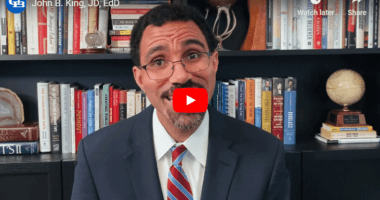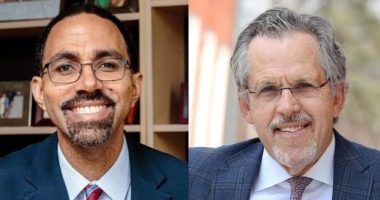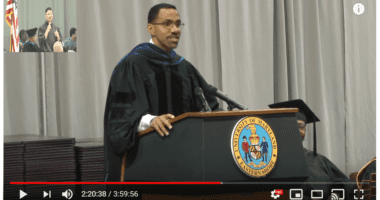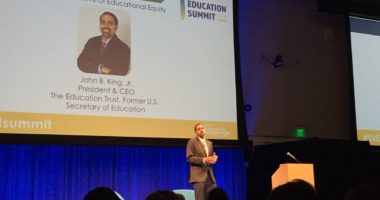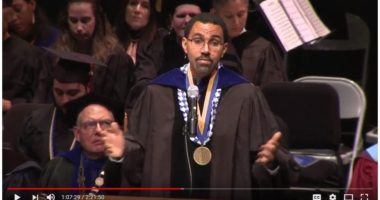Stand Up to be an Activist for Educational Equity from Wherever You Sit
On Wednesday, Nov. 14, 2018, John B. King Jr. delivered the first in a series of lectures at the University of Southern California to celebrate the Rossier School of Education’s centennial. King spoke about how everyone can stand up to be an activist for education equity from wherever they sit.
Thank you for the kind introduction and a special thanks to Dean Gallagher for welcoming me to campus today to celebrate the Rossier School of Education’s centennial at the University of Southern California.
I’d like to start by acknowledging that even as we observe this milestone anniversary for Rossier, this community and its neighbors also have experienced sudden and staggering loss.
The shooting in nearby Thousand Oaks last week resulted in a dozen precious lives cut short at an event for college students. The “Camp Fire,” the most destructive and potentially deadliest wildfire in California’s history, is still burning. The blaze has claimed more than 40 lives and charred an area of land larger than the city of Detroit. And not too far from us here in Los Angeles, about 200,000 people have been displaced by the Woolsey Fire, even as fire departments are responding to another blaze just west of Thousand Oaks.
Amid this heartbreak, there are stories of heroic first responders and people coming together, doing what they can with what they have to aid their neighbors.
In a community a few dozen miles from here, I read about a man named Tim Biglow who, with a determined group of neighbors, took to the streets as ash from the fires rained down from the sky. The group used their own fire hoses to fight flames and knocked down fences and cleared brush, trying to remove anything from people’s properties that could fuel the fire. Before city officials could arrive to sweep their streets, this group of volunteers shut off gas lines and helped people evacuate.
And that, really, is the true essence of America. People standing up to support those who need help … people identifying a need and leading from where they are to make their communities even stronger.
It’s that spirit that I’d like to talk with you about today.
I’d like to take a little time to reflect on how everyone in this room can lead from where you are, can stand up from wherever you sit, to be an activist for the most pressing issue in education today … the need to vastly expand educational equity.
Because that’s exactly what we need in these times: unapologetic activists for an excellent education that opens doors of opportunity to every child.
We know the stakes are so high.
Now, perhaps more than ever before, a quality education is vital to individual prosperity, the health of our democracy, and the strength of our nation.
But today, a child’s zip code, the color of her skin, the language she speaks at home, and the socioeconomic status of her family still all weigh too heavily in the determination of that child’s future.
Still, today, far too many young people—especially youth of color and youth from low-income backgrounds—do not have access to the opportunities that a great education makes possible.
Children of color and children living in poverty often have the least access to quality preschool, high academic expectations, and safe schools. They often are cut off from challenging coursework and outstanding teachers. They are suspended, expelled, and drop out of school at higher rates than their peers. And they are less likely to make it to post-secondary success, as so many of you have achieved or are striving for.
In America, our children’s potential is ubiquitous—but educational opportunity is not evenly distributed—and we know these disparities translate into inequities in academic achievement and in outcomes in our society.
Nationally, greater shares of Black and Latino students perform at below basic levels in math and reading in elementary school than their White peers. And there are gaps of 10- and 20-percent between the high school graduation rates for Black and Hispanic students and White students.
We see disparities play out in society when the median household wealth of White families is about $142,000, while the household wealth of Hispanic families is just $13,000 … and Black families fare worse at only $11,000. That’s a wealth gap of more than $130,000 between White and Black families.
We see disparities in California, too.
While there are successes to celebrate … steadily increasing high school graduation rates and more students of color entering the state’s public colleges and universities … there are significant challenges that need to be addressed.
Recent national test results show a backward slide for California’s Black students in both fourth and eighth grade math. There isn’t one California county where the majority of Latino students is meeting proficiency standards in math or English language arts, which is particularly worrisome for a population of children that makes up the majority of students in California’s public school system. And students from low-income backgrounds in California are performing next to last in the nation in fourth grade math.
California also demonstrates some of the greatest income inequality in the nation. Here in Los Angeles, households in the top income percentile ($271,041) earn about 11 times as much as households in the bottom 20 percent ($25,190).
Certainly, California has an exciting opportunity to build on promising work already being done to address disparities in education with the recent election of a new governor, lieutenant governor, and the soon-to-be decided state superintendent of public instruction. All of these leaders have the powerful choice to stand up for educational equity from where they now sit.
I’d like to suggest a few things to consider in this equity-advancing work, particularly for state leaders, in California and, indeed, all over the country.
Part of the work should entail continuing to invest in meaningful systems of accountability that direct attention to the schools and districts that are struggling most.
California’s School Dashboard—which gives educators, families, students, and advocates a more holistic look at school performance—is a start. It can include even more vital information that’s currently disbursed across multiple places in the state system, and the dashboard can be more user friendly so that data can be understood and leveraged by everyone as a real tool to promote education improvement.
State leaders also can stand up for educational equity by adequately funding public schools while ensuring that the resources generated for students with the greatest needs are allocated equitably.
One of the biggest misconceptions around the term “equity” is that it means the same thing as equality, and that these words can be used interchangeably, especially in education.
But understanding that historically underserved students need additional resources to achieve is a matter of equity, not equality. Students who have not been well served by our systems need more, not equal and certainly not less, supports in order to thrive.
This is an especially salient issue in California, which ranks 41st nationally in per-pupil spending after adjusting for differences in the cost of living. The state also has more students per teacher, per administrator, and per school counselor than any other state.
My organization, The Education Trust, recently analyzed school funding in states across the country and found that the U.S. spends approximately 7 percent — or $1,000 — less per pupil on students educated in our nation’s highest poverty districts than those educated in the wealthiest.
Fortunately, in California, the state’s Local Control Funding Formula has helped to make district funding more equitable, and in many communities, families and students have a greater voice in decisions affecting them, and made by their schools and districts. Those are things to be celebrated. Policymakers can take important steps to adequately fund LCFF and make investments in equity paramount.
To stand up for educational equity, state leaders across the country and here in The Golden State also must expand access to rich, rigorous learning opportunities for all students, from preschool through high school.
California has smartly increased funding for public preschool, yet there’s still an unmet need.
Only 37 percent of 4-year-olds and a little over 10 percent of 3-year-olds in California are enrolled in public preschool—when we know that quality early learning can give children, especially those who are most vulnerable, a strong foundation for success in school and in life.
And in a state known for its science, tech, and engineering industries, students lack access to rigorous coursework in these subjects.
Almost 40 percent of California public high schools, for example, do not offer physics and a quarter do not offer chemistry. How can California students make the choice to become the marine biologists working along our coasts, the researchers discovering cures for disease, and the computer scientists building the tools of tomorrow if they cannot enroll in the classes that are foundational to these fields, and that are often required for college level study?
There’s work for state leaders to do here, and—particularly relevant for this audience and this moment when the Rossier School of Education is celebrating 100 years and looking to the next century and the challenges that must be solved—there is vital work to do to strengthen and support the teacher workforce.
Rossier has a strong legacy in this regard, stretching back to the 1800s when Los Angeles was a frontier town crisscrossed with dirt roads. Since that time, the school of education has trained thousands and thousands of teachers and school administrators. More than 200 Rossier graduates also have led California school districts, including more than 75 current superintendents.
To be sure, schools of education play a crucial role in leading for educational equity.
One important way that ed schools can do this, especially today, is to use data to determine where the real needs are in our public schools and then do work to fulfill those needs.
For example, 60 percent of children ages zero to five in California speak a language other than English at home. This means that future educators, particularly in this state, will need to be equipped to serve dual-language learners.
It’s critically important that more schools of education offer bilingual credentials, that more bilingual young people choose to go into teaching, and that more teachers who already are fluent in one or more languages earn their bilingual authorization.
As Rossier has done since its inception, it is responding to a demonstrated need with action.
Just last year the World Masters in Language Teaching program launched to address the growing demand for bilingual education teachers. Now, candidates are developing teaching fundamentals in two languages and cultures and getting the chance to spend part of their time studying at partner universities abroad.
Education schools also lead with equity in mind when they prepare teachers and school leaders to be activists for students who have been—and continue to be—underserved by our systems.
If, as the late civil rights leader Julian Bond once said, “Violence is Black children going to school for 12 years and receiving six years’ worth of education,” then justice for Black and other disenfranchised youth is receiving the education they need for liberation from all forms of oppression.
Here at Rossier, 78 percent of graduates from the Master of Arts in Teaching program are working in high-needs schools. Your field programs are supporting students from low-income backgrounds so they may successfully make the transition from high school to college. And your Center for Education, Identity, and Social Justice is helping educators to combat discrimination and to see how race, gender, religion, sexual orientation, and ethnicity intersect.
Ed schools—and Rossier is a model—can lead for educational equity by supporting teacher candidates to recognize and confront their own biases, which every person carries, before they get into the classroom; to learn about the systemic and institutional barriers to equity that they are likely to face when they start teaching, and to equip them to dismantle those barriers in their classrooms, schools, and communities.
Indeed, one of the most powerful ways that ed schools—and any postsecondary institution—can stand up for equity is through an explicit focus on diversity.
More than 60 percent of students at Rossier are students of color. Diversity in terms of race, socioeconomic status, ethnicity, sexual orientation, religion, and language, enriches education.
When students here learn with diverse peers and from diverse faculty, perspectives are broadened and empathy and tolerance increase—all good things for future and practicing educators and the work they ultimately do in service of young people.
USC has been a leader in lifting up the importance and value of diversity in higher education.
The university’s Race and Equity Center is producing rigorous, actionable research and tools to advance racial equity for institutions of higher education, businesses, and other organizations all over the country. I’m also heartened to see USC launch a new Center for Excellence in Diversity and Inclusion, which will serve as a focal point for these endeavors across the university. And I’m encouraged by USC’s new $50 million effort that aims to broaden and deepen the university’s cultural diversity and ensure that faculty more closely reflect the rich makeup of USC’s student body.
USC’s commitment to diversity, in fact, just might be rubbing off on the city.
Recently, in an effort to boost diversity, inclusion, and engagement between the growing technology industry in Los Angeles and the surrounding community, more than 80 venture capitalists and tech leaders joined with LA Mayor Eric Garcetti and the Annenberg Foundation to launch a new effort called PledgeLA.
As part of this initiative, venture capitalists will support organizations that are making a difference in the community. And entrepreneurs, investors, and tech companies have pledged to actively improve diversity, equity, and inclusion, both in their investment decisions and at all levels in their organizations.
This is a step in the right direction, especially when recent reports show that a lack of diversity and an abundance of unconscious bias are threatening the innovation economies in both LA and Silicon Valley. A study released this spring by the National Urban League, for example, revealed that at companies including Twitter, Google, Uber, and Facebook, fewer than 3 percent of tech workers identify as Black.
Strictly from a focus on the bottom line, this is bad for business. … Especially when diversity has been linked to enhanced financial performance and increases in productivity for many companies.
I’ve spoken with you today about how policymakers and schools of education can lead for educational equity, but now I’d like to turn to the educators and aspiring educators in the room.
Educators are at the forefront of a new era in the struggle for equity and social justice.
Educators teach children affected by the water crisis in Flint. Educators teach children who have witnessed shooting deaths of unarmed Black men and women at the hands of police. Educators teach children who fear that their parents might be next, or that their families will be ripped apart by cruel immigration enforcement. Educators teach children in crumbling schools in Detroit and Compton. And educators teach children who listen to racist, sexist, xenophobic, divisive political rhetoric and question whether they can still find themselves in the American Dream.
Educators become activists, as Bettina Love, associate professor at the University of Georgia has said, when they “disrupt, agitate, and abolish systems, policies, and instruction that deny children of color not only their education, but their humanity.”
Today, I’d like to suggest that educators can stand up to be activists for educational equity in three key ways: by teaching for social justice, by empowering others in this movement, and by loving your children—which will require you to truly see their humanity.
Teaching for social justice means nurturing in your students an awareness of the things that still need solving in our communities and in our country—even as you help students to build a strong foundation in academic learning.
It means teaching students the history of resistance to slavery and of the ongoing movement for civil rights, about Black and Brown engineers, artists, authors, and inventors, and reminding young people of color that their brilliance is wrapped up in the genius of those who came before them.
Teaching for social justice also means helping students develop the skills to become activists for issues that they care about. Young people in this country, in fact, long have been marching toward equity and justice and have urged adults also to fight with urgency.
In the 1960s, students right here in East LA—just a few miles from USC’s campus—walked out of their classrooms to demand that California’s public education system provide the same educational opportunities to Latino students as it did to White students.
And about three years ago at a rally sponsored by The Education Trust-West, 1,000 high school and community college students marched from the California Department of Education to the steps of the state capitol building. They marched to assert that Black Minds Matter—and to call for a renewed commitment to equity in California’s public schools and colleges.
Indeed, today, students all across the country are driving a national push to increase voter participation in our elections, to ensure that public schools are safe and free from gun violence, and to demand that colleges are accessible, diverse, and inclusive.
Teaching for social justice means empowering our young people. And to all the high school students in the room today, it’s you who, in so many ways, are already poised to be activists and leaders yourselves.
Today, I’d also like to suggest that, to be activists for equity, teachers and those aspiring to work in schools must build the larger movement for social justice in education.
Help your students to envision themselves as teachers and school leaders. Mentor other educators of color. Push your schools and districts to recruit and retain diverse teachers. Stand up for the supports that those educators need once they are hired and teaching in classrooms.
Increasing educator diversity is such a vital part of this work—especially when a majority of students in our public schools are students of color, but when only 18 percent of teachers in America are teachers of color. California’s educators also don’t reflect the diversity of students in the state. While 54 percent of California students are Latino, just 21 percent of teachers are. And while 6 percent of students in California are Black, only 4 percent of teachers are Black.
My final recommendation for educators who wish to lead for educational equity is simple on its face, but more complex in practice: Love your children.
All educators go into the field because of an abundance of care for students, but to be an activist for educational equity, you must love your children enough to see their full humanity.
So many students experience incredible adversity. Difficult family circumstances. Poor health. Violence. Poverty. Hunger. Mental health challenges. Addiction.
As educators, you must challenge yourselves to see those things. Truly see those things. You must seek to understand what your students may be struggling with at home and in their community. And even as you identify challenges, you must do the work to recognize your students’ assets and strengths.
For those of you studying at the Rossier School of Education, your experience here has shown you that students’ success in school is dependent upon more than quality instruction and high expectations, although both are important. There are other things that matter, too.
You have learned that student success also requires you to meet children’s social, emotional, and behavioral needs in schools and classrooms that are welcoming and safe. You know that students’ success relates to their engagement in school—which is dependent on the relevancy of classroom assignments and other factors that the new USC Center EDGE is studying and communicating about. You know that student success requires monitoring chronic absenteeism and creating systems to ensure no student falls through the cracks. And you know that supporting student success also often requires connecting students with wraparound services from transitional housing, to health clinics, to food pantries.
Great educators who love the whole child and recognize a child’s humanity—even and especially the challenging parts of that child’s life—can make a tremendous difference.
I know this from personal experience.
My mom passed away when I was eight, my dad when I was twelve. During the years when I lived with my father, he struggled with undiagnosed Alzheimer’s disease. Life at home was scary and unpredictable. I did not know what my dad would be like from one night to the next. And as he got sicker, I took on more and more responsibility for figuring out how to pay the bills, get food, and manage the household. But throughout that period, school—and my New York City public school teachers—provided a refuge. They created a space where I felt safe, challenged, and engaged—where I could be a kid when I couldn’t be a kid outside of school.
Now, no life is a straight line. After my dad passed away, I moved around between family members and schools. I struggled with the losses I experienced in my youth and I was angry. I made bad choices and I got kicked out of high school. I often say I was the first Secretary of Education to have been kicked out of high school, but I hope I won’t be the last—because I recognize the power of second chances.
After I was kicked out of high school, I was again fortunate to have public school teachers, and family members, and counselors who chose to invest in me. They could have looked at me as an African-American, Latino young man with a family in crisis, and they could have given up on me. But, instead they saw my potential. They gave me hope for the future.
I know many of you will encounter a student with a story like mine. Those of you who choose to be activists for educational equity will see the promise in that child.
Closing
I’ll close by noting that so often, when those who are advantaged hear the word “equity” in education, they think about what might be taken away from them and their kids and given to someone else and someone else’s kids over there … those people who aren’t “us.” Especially today, there is a tendency to “other-ize”—to put people into categories. And those who are advantaged can sometimes be jealous with their resources.
It’s here where the words of Dr. Martin Luther King, Jr. come to my mind.
In his famous Letter from a Birmingham Jail, Dr. King wrote that injustice anywhere is a threat to justice everywhere. And throughout his life he argued that we are all caught up in an “inescapable network of mutuality, tied together in a single garment of destiny.”
As he said in his Commencement address to Oberlin College in 1965, “Whatever affects one directly, affects all indirectly. I can never be what I ought to be until you are what you ought to be. This is the interrelated structure of reality.”
That is why I believe that equity, in fact, benefits us all. And in this way, equity really is justice.
I’m grateful to be an activist for educational equity and justice alongside all of you gathered here today. And I cannot wait to see the ways in which the USC Rossier School of Education will help California and the entire nation deliver on the promise of educational opportunity for a new century and for all our children.
Thank you.

